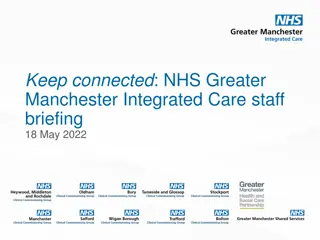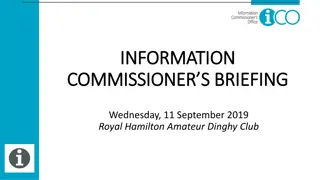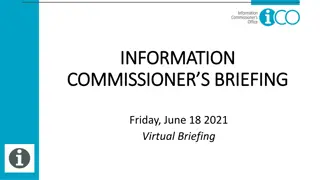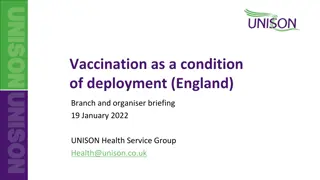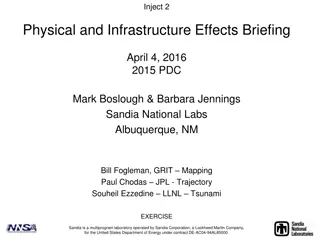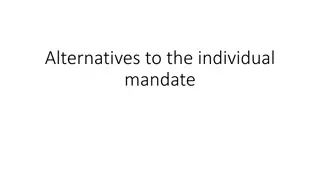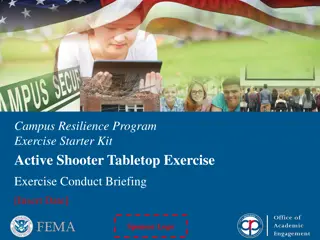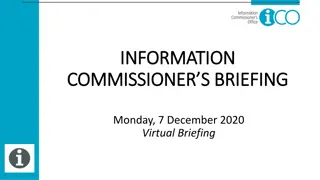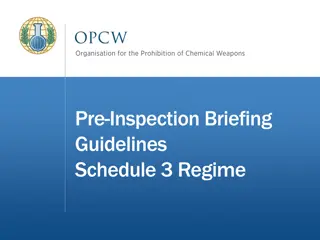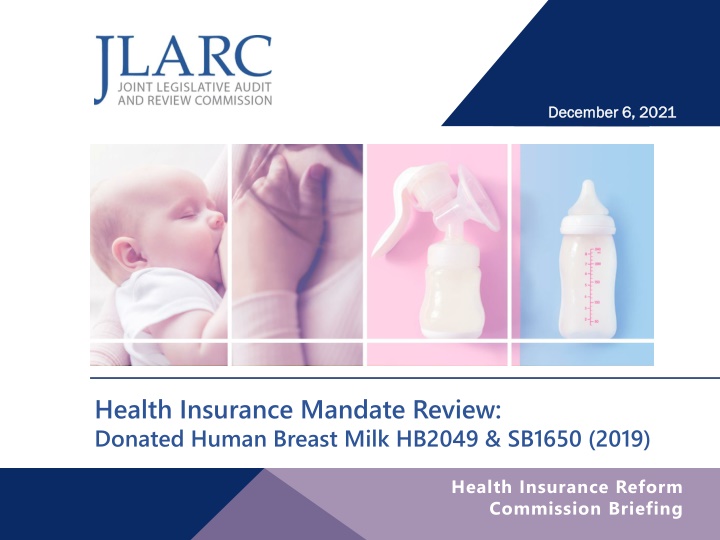
The Benefits of Pasteurized Donated Human Breast Milk
Discover the positive impact of pasteurized donated human breast milk (PDHM) in reducing gastrointestinal disorders in low birthweight infants. Learn about the financial implications and coverage provided by HB2049/SB1650, which aim to expand the accessibility of PDHM for infants in need.
Download Presentation

Please find below an Image/Link to download the presentation.
The content on the website is provided AS IS for your information and personal use only. It may not be sold, licensed, or shared on other websites without obtaining consent from the author. If you encounter any issues during the download, it is possible that the publisher has removed the file from their server.
You are allowed to download the files provided on this website for personal or commercial use, subject to the condition that they are used lawfully. All files are the property of their respective owners.
The content on the website is provided AS IS for your information and personal use only. It may not be sold, licensed, or shared on other websites without obtaining consent from the author.
E N D
Presentation Transcript
December 6, 2021 December 6, 2021 Health Insurance Mandate Review: Donated Human Breast Milk HB2049 & SB1650 (2019) Health Insurance Reform Commission Briefing
Questions for JLARC Stage 2 Review Is there evidence that the proposed treatment is effective? How commonly used and available is the proposed treatment? What is the cost of the treatment for individuals without insurance coverage? JLARC 2
In Brief Pasteurized donated human breast milk (PDHM) effectively reduces the rate of gastrointestinal disorders common in low birthweight infants and may reduce rates of other disorders for these infants. PDHM with fortifier is most often provided to very low birthweight infants in hospitals. Cost of PDHM with fortifier can be substantial and is generally borne by hospitals. Few patients pay out of pocket for PDHM or fortifier. HB2049/SB1650 would enable hospitals to expand their use of PDHM and fortifier for low birthweight infants by providing additional revenue to cover PDHM costs, and would assist patients who do pay out of pocket. JLARC 3
In this presentation Background Medical efficacy and use of donated human breast milk Financial impact on individuals without coverage Coverage provided by HB2049/SB1650 JLARC JLARC 4
HB2049/SB1650 would require coverage of PDHM and fortifiers Would require coverage of pasteurized human donated breast milk (PDHM) and human-derived fortifier by private insurance plans and Virginia s Medicaid program PDHM must be ordered by a licensed medical practitioner for infants with certain conditions Infant age 6 months or younger Mother s own milk is not sufficiently available Infant has low body weight, is at risk for necrotizing enterocolitis, or has other conditions PDHM must be from a milk bank that meets quality guidelines established by VDH VDH does not currently have efforts underway to develop guidelines Note: HB367 (2020 session) would require coverage of PDHM and fortifiers by Medicaid. JLARC 5
PDHM can supplement or replace mothers milk PDHM may be used when the mother s own milk is not available Infant has difficulty feeding from mother Mother has difficulty producing sufficient amounts of milk Mother s milk has transmissible disease or contaminants (e.g., prescription medications, illegal drugs, marijuana, alcohol, tobacco) Mothers often cannot produce a sufficient amount of milk for infants born prematurely PDHM is typically used as a bridge until mother s own milk is available JLARC 6
PDHM is collected by milk banks and provided to hospitals and patients Most PDHM in U.S. is collected by nonprofit milk banks affiliated with HMBANA HMBANA has 28 milk banks in the U.S. and 3 in Canada HMBANA milk banks required to meet quality guidelines HMBANA milk banks sell PDHM to hospitals and patients for a per-ounce fee plus shipping 1 HMBANA milk bank in Virginia: The King s Daughters Milk Bank in Norfolk Part of The Children s Hospital of the King s Daughters Largest provider of PDHM in Virginia HMBANA = Human Milk Banking Association of North America JLARC 7
Milk banks must screen donors and pasteurize PDHM to prevent contaminants PDHM must be pasteurized to remove viral or bacterial contaminants Donors must be screened to prevent other contaminants Other contaminants include prescription medications, illegal drugs, marijuana, alcohol, tobacco Screening may include a health questionnaire, blood test, and confirmation of donor s health from a physician PDHM from individual donors is pooled to dilute the concentration of any remaining contaminants PDHM is perishable so typically frozen for shipping and storage JLARC 8
Fortifiers add critical nutrients to PDHM for low birthweight infants Fortifiers are additives that provide additional proteins, minerals, and other nutrients not sufficiently available in PDHM or mother s own milk but needed by low birthweight infants Fortifiers are manufactured and sold by for-profit suppliers Fortifiers are typically sold to hospitals and NICUs and added to PDHM and mother s own milk before given to infants NICU = Neonatal intensive care unit JLARC 9
At least 12 other states require coverage of PDHM by private insurers or Medicaid JLARC 10
In this presentation Background Medical efficacy and use of donated human breast milk Financial impact on individuals without coverage Coverage provided by HB2049/SB1650 JLARC JLARC 11
Very low birthweight infants are rare but susceptible to numerous health complications Under 2% of infants born with very low birthweight Estimated 1,400 Virginia infants in 2019 Typically born 8+ weeks premature Very low birthweight infants at risk for severe complications Necrotizing enterocolitis: gastrointestinal condition that can lead to lengthy hospitalizations and death Bronchopulmonary dysplasia: chronic lung disease resulting from poor development of lung tissue Retinopathy of prematurity: retina condition that is the leading cause of blindness in premature infants Sepsis: life-threatening body-wide infection spread through blood Very low birth weight = less than 1,500 grams (~ 3 pounds) or < 30 weeks gestation JLARC 12
PDHM is effective treatment for gastrointestinal disorders in very low birthweight infants Strong evidence in research literature shows PDHM reduces the rate of necrotizing enterocolitis (NEC) in very low birthweight infants 4.3% of very low birthweight infants in Virginia develop NEC Numerous studies find a lower rate of NEC among infants receiving PDHM compared with formula For example, one study found the availability of PDHM in hospitals reduced the risk by 2.6 percentage points Studies consistently find PDHM associated with a lower rate of surgery for severe NEC According to medical experts, PDHM, which is typically paired with a fortifier, is an effective treatment for infants at risk of developing NEC JLARC 13
PDHM may be effective for other disorders common in low birthweight infants Smaller number of studies suggest PDHM may reduce rates of other disorders Bronchopulmonary dysplasia Retinopathy of prematurity Sepsis (including meningitis) Additional research needed to confirm the efficacy of PDHM for these disorders Medical experts said PDHM, which is typically paired with a fortifier, may reduce the risks of these disorders JLARC 14
Most PDHM with fortifier in Virginia is mainly provided to very low birthweight infants in NICUs Children s Hospital of the King s Daughters (CHKD) Milk Bank provides PDHM mainly to NICUs in Virginia 20 NICUs throughout Virginia 7 newborn nurseries ~75% of CHKD Milk Bank s PDHM went to hospitals (FY21) ~176,000 ounces of PDHM to Virginia infants in inpatient/outpatient settings CHKD Hospital provided PDHM to as many as ~190 low birthweight infants in the CHKD NICU (FY21) NICU = Neonatal intensive care unit JLARC 15
PDHM with fortifier is less widely used for infants in outpatient settings Infants are less likely to receive PDHM after leaving the hospital Some infants will receive mother s milk after discharge PDHM may only be needed to supplement mother s milk Out of pocket cost of PDHM may be a challenge for some families Infants may no longer use a fortifier after leaving the NICU Infants gastrointestinal systems may have matured enough to transition off fortifier JLARC 16
In this presentation Background Medical efficacy and use of donated human breast milk Financial impact on individuals without coverage Coverage provided by HB2049/SB1650 JLARC JLARC 17
Cost of PDHM can be more substantial when adding a fortifier Cost of PDHM can be as high as $144 per day for an infant relying exclusively on PDHM* Cost is lower for newborns needing less PDHM or when it is supplementing the mother s own breast milk Cost of PDHM is substantially higher with a fortifier Staff with one hospital estimated $12,500 for PDHM with fortifier for 1 infant in the NICU 3 months Cost of fortifier alone could be $8,000 $10,000 over this period * Assumes PDHM at $4.50/ounce and 32 ounces/day at 2 months age JLARC 18
Cost of PDHM and fortifier is mostly borne by hospitals; few patients pay out-of-pocket VCU and UVA hospital staff said their hospitals generally absorb the cost of PDHM with a fortifier VCU Health System spent ~$680,000 in FY21 on PDHM and fortifier Other hospitals likely absorb the cost of PDHM and fortifier, according to medical experts Some patients continue receiving PDHM after leaving the NICU and may pay out-of-pocket However, infants are less likely to need a fortifier after leaving the NICU JLARC 19
In this presentation Background Medical efficacy and use of donated human breast milk Financial impact on individuals without coverage Coverage provided by HB2049/SB1650 JLARC JLARC 20
Insurance plans generally do not cover PDHM or fortifier TRICARE is the only insurer in Virginia covering PDHM Limited to service members and their families Virginia s Medicaid program does not cover PDHM or fortifier As of 2019, none of the 7 private insurance plans surveyed by BOI covered PDHM or fortifier One plan was in the process of developing a coverage policy BOI = Virginia Bureau of Insurance JLARC 21
HB2049/SB1650 would apply to insurance plans covering approximately one-quarter of Virginians Note: 38.2-6506 A 1 prohibits qualified health plans (including those sold on the exchange) from providing state mandated benefits that are in addition to the essential health benefit (EHB). Any state mandate enacted after 2011 is considered in addition to the EHB. JLARC 22
HB2049/SB1650 would mainly allow hospitals to treat more infants with PDHM and fortifier HB2049/SB1650 would provide an additional revenue source for hospitals to cover the cost of PDHM and fortifier Hospitals have varying ability to absorb the cost of PDHM and fortifier Some hospitals limit PDHM and fortifier to the smallest and sickest premature infants One hospital reported further limiting PDHM and fortifier during the pandemic CHKD anticipates supply of PDHM could meet demand with insurance coverage JLARC 23
JLARC staff for this report Kimberly Sarte, Associate Director Jamie Bitz, Chief Legislative Analyst Mitchell Parry, Associate Legislative Analyst JLARC JLARC http://jlarc.virginia.gov http://jlarc.virginia.gov/ / (804) 786 (804) 786- -1258 24 1258
Appendix: Literature reviewed American Academy of Pediatrics. Breastfeeding and the use of human milk. Pediatrics, 2012; 129(3): e827- e841. American Academy of Pediatrics. Donor Human Milk for the High-Risk Infant: Preparation, Safety, and Usage Options in the United States. Pediatrics, 2017; 139(1). American Academy of Pediatrics. Promoting Human Milk and Breastfeeding for the Very Low Birth Weight Infant. Pediatrics, 2021; 148(5). Arnold, L. D. W. Cost savings through the use of donor milk: Case histories. Journal of Human Lactation, 1998; 14(3): 255-258. Arslanoglu, S., et al. Fortification of human milk for preterm infants: Update and recommendations of the European milk bank association (EMBA) working group on human milk fortification. Frontiers in Pediatrics, 2019; 17(76): 1-14. Bai, Y., & Kuscin, J. The current state of donor human milk use and practice. Journal of Midwifery and Women s Health, 2021; 66(4): 478-485. Belfort, M. B., Drouin, K., Riley, J. F., Gregory, K. E., Philipp, B. L., Parker, M. G., & Sen, S. Prevalence and trends in donor milk use in the well-baby nursery: A survey of northeast United States birth hospitals. Breastfeeding Medicine, 2018; 13(1): 34-41. Bharwani, S. K., Green, B. F., Pezzullo, J.C., Bharwani, S. S., Bharwani, S.S., & Dhanireddy, R. Systematic review and meta-analysis of human milk intake and retinopathy of prematurity: A significant update. Journal of Perinatology, 2016; 36(1): 913-920. JLARC 25
Appendix: Literature reviewed, contd. Buckle, A., & Taylor, C. Cost and cost-effectiveness of donor human milk to prevent necrotizing enterocolitis: Systematic review. Breastfeeding Medicine, 2017; 12(9): 528-536. Cacho, N. T., Parker, L. A., & Neu, J. Necrotizing enterocolitis and human milk feeding: A systematic review. Clinical Perinatology, 2017; 44(1): 49-67. Carroll, K., & Hermann, K. R. The cost of using donor human milk in the NICU to achieve exclusively human milk feeding through 32 weeks postmenstrual age. Breastfeeding Medicine, 2013; 8(3): 286-290. Colaizy, T. T. Donor human milk for very low birth weights: Patterns of usage, outcomes, and unanswered questions. Current Opinions in Pediatrics, 2015; 27(1): 172-176. Corpeleijn, W. E., et al. Effect of donor milk on severe infections and mortality in very low-birth-weight infants: The early nutrition study randomized clinical trial. JAMA Pediatrics, 2016; 170(7): 654-661. Hard, A., Nilsson, A. K., Lund, A., Hansen-Pupp, I., Smith, L. E. H., & Hellstrom, A. Review shows that donor milk does not promote the growth and development of preterm infants as well as maternal milk. Acta Paediatrica, 2019; 108(1): 998-1007. Johnson, T.J., et al. The Economic Impact of Donor Milk in the Neonatal Intensive Care Unit. The Journal of Pediatrics, 2020; 224: 57-65. Kantorowska, A., et al. Impact of Donor Milk Availability on Breast Milk Use and Necrotizing Enterocolitis Rates. Pediatrics, 2016; 137(3). Miller, J., et al. A Systematic Review and Meta-Analysis of Human Milk Feeding and Morbidity in Very Low Birth Weight Infants. Nutrients, 2018; 10, 707. JLARC 26
Appendix: Literature reviewed, contd. Parker, M. G. K., et al. Pasteurized human donor milk use among US level 3 neonatal intensive care units. Journal of Human Lactation, 2013; 29(3): 381-389. Perrin, M. T., Fogleman, A. D., Davis, D. D., Wimer, C. H., Vogel, K. G., & Palmquist, A. E. L. A pilot study on nutrients, antimicrobial proteins, and bacteria in commerce-free models for exchanging expressed human milk in the USA. Maternal and Child Nutrition, 2017; 14(56): 1-9. Perrine, C. G., & Scanlon, K. S. Prevalence of use of human milk in US advanced care neonatal units. Pediatrics, 2013; 131(6): 1066-1071. Premkumar, M., Pammi, M., & Suresh, G. Human milk-derived fortifier versus bovine milk-derived fortifier for prevention of mortality and morbidity in preterm neonates. Cochrane Database of Systematic Reviews, 2018; 10: 1-11. Silano, M., et al. Donor human milk and risk of surgical necrotizing enterocolitis: A meta-analysis. Clinical Nutrition, 2019; 38: 1061-66. Spatz, D. L., Robinson, A. C., & Froh, E. B. Cost and use of pasteurized donor human milk at a children s hospital. JOGNN, 2018; 47(4): 583-588. Steele, C. Best practices for handling and administration of expressed human milk and donor human milk for hospitalized preterm infants. Frontiers in Nutrition, 2018; 5(76): 1-5. Sullivan, S., et al. An Exclusively Human Milk-Based Diet Is Associated with a Lower Rate of Necrotizing Enterocolitis than a Diet of Human Milk and Bovine Milk-Based Products. The Journal of Pediatrics, 2010; 156: 562-7. JLARC 27
Appendix: Literature reviewed, contd. Villamor-Martinez, E., Pierro, M., Cavallero, G., Mosca, F., Kramer, B. W., & Villamor, E. Donor human milk protects against bronchopulmonary dysplasia: A systematic review and meta-analysis. Nutrients, 2018; 10(238): 1-16. Zanganeh, M., Jordan, M., & Mistry, H. A systematic review of economic evaluations for donor human milk versus standard feeding in infants. Maternal and Child Nutrition, 2021; 17(1): 1-15. Zhou, J., et al. Human Milk Feeding as a Protective Factor for Retinopathy of Prematurity: A Meta-analysis. Pediatrics, 2015; 136(6): e1576-86. JLARC 28
Appendix: Medical experts interviewed University of Virginia Children s Hospital Children s Hospital of Richmond at VCU The King s Daughters Milk Bank at Children s Hospital of The King s Daughters JLARC 29






